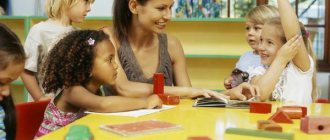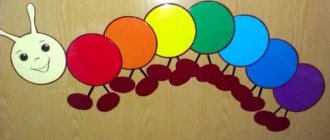Consultation for teachers “Project method in the activities of teachers of preschool educational institutions in accordance with the Federal State Educational Standard of Preschool Education”
Consultation for preschool teachers
Project method in the activities of preschool teachers
in accordance with the Federal State Educational Standard
Currently, in preschool education, traditional education has been replaced by developmental education, which is aimed at developing creative abilities, developing cognitive interest and the need for active creative activity in preschoolers. The project method fully complies with the requirements of the Federal State Educational Standard for Educational Education and can be implemented both within the framework of the cognitive development of preschool children and through the integration of educational areas.
Method is a didactic category. This is a set of techniques, operations of mastering a certain area of practical or theoretical knowledge, one or another activity. This is the path of cognition, a way of organizing the process of cognition. Therefore, if we talk about the project method, we mean precisely the way to achieve a didactic goal through a detailed development of the problem (its technologization), which should result in a very real, tangible practical result, formalized in one way or another.
Project method
- educational technology that allows you to create a natural environment for the formation of integrative qualities (personal, intellectual, physical) in preschoolers. The uniqueness of using technology in kindergarten is that it allows children to develop not only personal, intellectual, and physical qualities, but also the ability to solve problems in children’s independent and joint activities.
Purpose of the project method
- to direct the cognitive activity of students towards a specific and planned result, which is obtained by solving a particular theoretically or practically significant problem.
This goal can be achieved with a combination of educational tasks:
1. Develop complex skills and abilities: research, reflective, self-evaluation.
2. Develop children's cognitive interest through creating a problem situation.
3. To form an active, independent and proactive position in children.
Features of pedagogical technology - project method:
- provides the opportunity to acquire the ability to pose and understand a problem and solve it, as it is focused on practical methods of acquiring knowledge;
- provides the opportunity for self-development and self-realization in personality-oriented interaction between a child and an adult, influences the formation of social and communicative competence of pupils, since, based on the specific age of the project participants, preschool projects are mainly of a joint nature (but, of course, the guiding role of an adult is important) ;
- allows for independent search and selection of information, which affects the formation of information and technological competence of project participants.
Projects vary in the dominant activities of the participants and can be:
research, informational, creative, role-playing. Based on the complexity and nature of contacts, projects can be divided into mono- and interdisciplinary. By duration - mini-projects, short-term and long-term projects.
Research projects
– projects aimed at carrying out a research search, the results of which are presented in the form of some kind of creative product (newspaper, dramatization, card index of experiences, cookbook, etc.).
Information projects
– aimed at collecting information about any object, familiarizing project participants with this information, analyzing it and summarizing facts intended for a wide audience. The structure of such a project consists of receiving and processing information, obtaining results and presentation.
Creative projects
– as a rule, they do not have a detailed structure of joint activities of participants and are classified according to the predominant type of creativity (artistic and visual, artistic and speech, design, theatrical, etc.).
Role-playing projects
– projects with game elements, when children take on the role of fairy tale characters and solve the problems in their own way.
Mono projects
– these are creative projects, because they use one type of activity.
Interdisciplinary
These are mixed projects.
Short term
– 1-2 weeks,
medium-term
– 2-3 months,
long-term
– for the entire academic year.
The main stages of pedagogical technology - the project method.
1. Value-oriented stage
: motivating children for project activities, revealing the significance and relevance of the topic, formulating the problem, introducing children to a problem situation. The child’s activity is aimed at consciousness and comprehension of the relevance of the topic, the motive of the activity, formulation of the problem, and entering into a problem situation.
2. Constructive stage
: planning the association of working groups, searching for literature, assistance in planning stages of practical activity, stimulating the search activity of children. Preschoolers are involved in project activities in groups or individually, collecting materials on the topic.
3. Practical stage
: coordination of children’s activities, consultation on emerging issues, and stimulation of activities are carried out. Children gradually implement the content of the activity to solve the problem.
4. The final stage
: the teacher assists in the design of the project, leads the children to formulate conclusions on the project problem. The results, the product of the activity are formalized, and conclusions are formulated.
5. Presentation stage
includes training of experts, organization of presentations. The project is presented and its main positions are defended.
6. Evaluative-reflective stage
involves stimulating children to self-analysis and self-esteem. There is an assessment of the pedagogical effectiveness of the project, a joint expert assessment with the children of the effectiveness of the work performed, and a self-assessment by the children of their contribution to the project and their own activities.
When implementing the project method technology, the educational process widely includes methods based on creating problem situations, stimulating the active cognitive activity of students, which involves searching for and solving complex issues that require updating knowledge, analytical activity, and the ability to see patterns and essential characteristics in individual facts. phenomena.
The set of methods can be represented by the following classification:
- Problem-search methods: problematic questions, thematic conversations, research (research project), step-by-step implementation of actions.
- Creative methods: presentation.
- Information methods: drawing up a model of information sources, collecting information for compiling booklets and organizational materials.
Personal development is facilitated by the use not of individual methods, but of an integral system of project activity, which ensures that preschoolers enter the processes of search, creativity, independent thinking, and the choice of means and methods of project activity.
Algorithm for working on a project.
- Identifying a problem that meets the needs of children and adults.
- Determining the goal of the project, forecasting and specifying the future result.
- The collision of knowledge and “ignorance”, awareness of a cognitive task.
- Activation of ways to obtain information.
- Obtaining the necessary information.
- Summarizing the information received.
- Planning activities, determining means of project implementation.
- Project implementation.
- Discussion of the result, progress of work.
- Presentation of results.
- Joint determination of the project development prospects.
We will determine the project activities of the teacher and children in stages
| Stages of project activity | Activities of a teacher | Children's activities |
| Formulates a problem for himself, leads children to the need to think about the problem situation | Learn to see the problem and formulate important questions |
| Sets goals based on children’s interests and needs | Indicate the purpose of the activity (become active researchers of the surrounding world) |
| 3. Specific intent | Thinks through, imagines what will happen and what result it will lead to | They participate in the discussion: how to organize this or that business, listen to any opinions, even non-standard and unexpected ones |
| 4. Planning | Determines the main stages of work with children depending on didactic, social, subject-material and individual-personal conditions | List activities, suggest games, participate in determining the sequence of operations |
| 5. Project implementation and constant reflection | Organizes and motivates various activities through their integration. Conducts reflection and timely correction of individual steps | Participate in a variety of activities, act as partners and assistants to the teacher |
| 6. Results analysis and presentation | Identifies positive and negative aspects in joint activities with children | Conduct a feasible analysis at the request of an adult. Participate in a game presentation of the results achieved |
Research objectives
specific for each age.
In early preschool age this is:
- children’s entry into a problematic play situation (the leading role of the teacher);
- activating the desire to look for ways to resolve a problem situation (together with the teacher);
- formation of initial prerequisites for research activities (practical experiments).
In older preschool age this is:
- formation of prerequisites for search activity and intellectual initiative;
- developing the ability to identify possible methods of solving a problem with the help of an adult, and then independently;
- developing the ability to apply these methods to help solve the problem, using various options;
- developing a desire to use special terms, conducting a constructive conversation in the process of joint research activities.
Thus, the project method in working with preschoolers today is an optimal, innovative and promising method that should take its rightful place in the preschool education system. The methodological foundations of project activities discussed above give an idea of the high degree of adaptability of innovative technologies to the specifics of preschool educational institutions.
Using the project method in preschool education as one of the methods of integrated teaching of preschoolers can significantly increase children's independent activity, develop creative thinking, children's ability to independently find information about an object or phenomenon of interest in different ways and use this knowledge to create new objects of reality. It also makes the educational system of preschool educational institutions open to the active participation of parents.
The specificity of using the project method in preschool practice is that adults need to “guide” the child, help discover a problem or even provoke its occurrence, arouse interest in it and “draw” children into a joint project. Based on a person-centered approach to training and education, ultimately, it should contribute to the development of individual creative activity of teachers in the development of strategy, tactics and technology of the educational process, promote the personal development of students, and ensure high-quality results of teaching activities.
The promise of the project method in the preschool educational system is that it provides the opportunity to develop observation and analysis of phenomena, comparison, generalization and the ability to draw conclusions, creative thinking, logic of knowledge, inquisitiveness of mind, joint cognitive-search and research activities, communication and reflective skills and much more that are components of a successful personality.
Memo “Formation of a pedagogical project”
- Pedagogical project, name, age group.
- Relevance.
Brief description of why there is a problem here and now?
- Justification of the significance of the project.
N.: insufficient knowledge of children about something...
- Objective of the project.
- Project objectives.
- Pedagogical principles.
This item is advisory in nature.
- Project type.
- Project type.
- Project participants.
- Duration.
- Forms of project implementation.
Direct educational activities.
- Educational conversations, excursions, etc.
- Productive activity.
- Interaction with parents.
- Educator.
- Preparatory stage. Purpose, content of work with children, content of work with parents.
Purpose, content of work with children, content of work with parents.
Purpose, content of work with children, content of work with parents.
References:
- https://detstvogid.ru/glavnaya-2 B.G. Golovina “Project activities in preschool educational institutions”
- https://www.maam.ru/ M. Kasymova “Project activities in kindergarten.”
- O.V. Tolstikova “Modern pedagogical technologies for the education of preschool children”, Ekaterinburg: State Autonomous Educational Institution of Further Professional Education SO “IRO”, 2014.-200 p.
Stages of organizing a project-based teaching method
The organization of the project-based teaching method provides for the sequence of the following stages:
- Determination of the research problem of the project, on its basis the formulation and setting of research objectives.
- Proposing a research hypothesis aimed at solving the assigned problems.
- Determination of research methods.
- Collection of data and primary information necessary for the research.
- Analysis of received data and information.
- Formulation and presentation of the final results of the study.
- Summing up: conclusions, adjustments (carried out through the use of the following methods: brainstorming, round table, creative reports, etc.).
Possible problems in organizing project-based teaching methods most often arise if the teacher does not have the necessary knowledge and experience:
- Can't keep statistics
- Does not know data processing methods
- Does not know various methods of creative activity
- Inability to logically and consistently organize the educational process as a whole
The choice of topics for project-based teaching methods in different situations is carried out differently:
- They are determined and approved by specialists from educational authorities within the framework of the approved educational program of the educational institution.
- Nominated directly by the teacher, based on the educational situation within the framework of the educational discipline that he teaches, as well as taking into account the interests, needs and abilities of the students.
- The proposal for project topics comes from the students themselves, who are guided not only by cognitive, creative and applied interests, but also by their own.
The topics of project-based teaching methods can relate to various fields of science, theoretical and practical issues of the curriculum. The main goal of the topic of the project-based teaching method is to deepen and expand the knowledge of individual students, as well as differentiate the educational process. Most often, the topic of the project is determined on the basis of a practical issue, which is relevant within the framework of practical life and requires the involvement of students’ knowledge not in one specific subject, but simultaneously from different areas. Thus, in the process of implementing the project, a natural integration of students’ knowledge is achieved.


